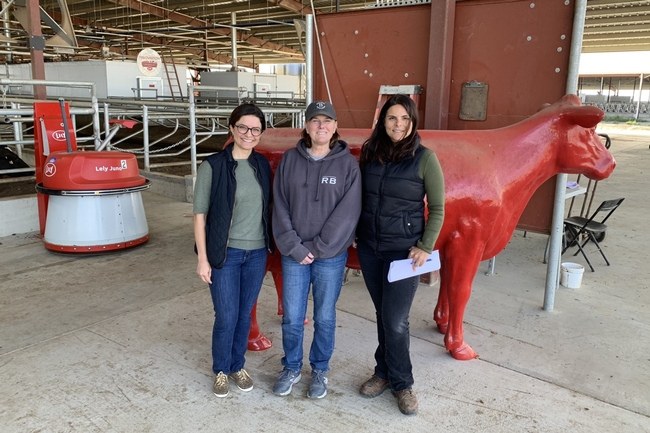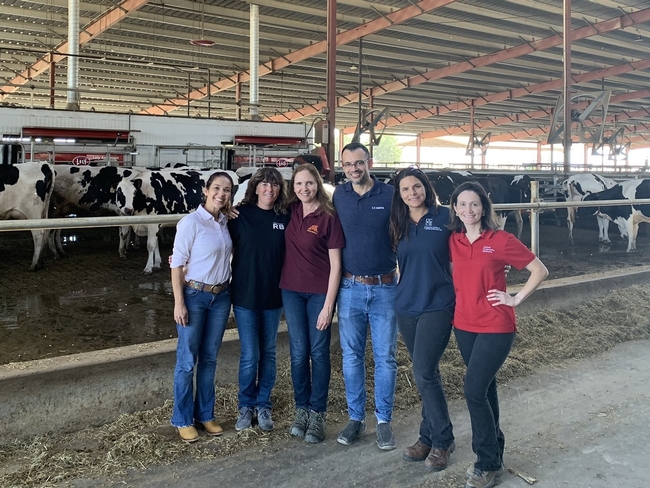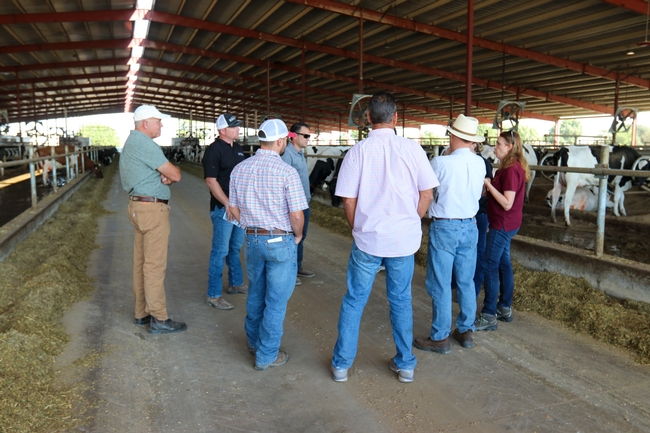UCCE advisor Bruno guides, learns from dairies switching to milking robots
Automatic milking systems increasingly used in California amid labor challenges
When third-generation dairy farmer Shonda Reid first saw a milking robot at a farm show 13 years ago, she immediately recognized that the technology represented the future. Her father, however, took a bit more convincing.
“I came home and showed him and said, ‘This is what we need to do.' And he thought I was kidding!” said Reid, dairy and farm manager for Fred Rau Dairy, which has a herd of 1,400 milk cows in Fresno County.
Years later, after the family had visited several dairies using automatic milking systems (AMS) across the U.S., they installed their first six robots in November 2021. By fall 2022, they had 24 robots, evenly split between two newly built “free stall” barns where the cows can freely go to the milking machines.
As Fred Rau Dairy was one of the first in California to implement AMS at such a scale, Reid and her team have been instrumental in growing practical knowledge on these systems. She also has been a valued partner to Daniela Bruno, University of California Cooperative Extension dairy advisor for Fresno, Madera and Kings counties.
“Automatic milking robots are not a new technology, but it's new to California,” said Bruno, noting that the milking robots were first used on small, family-run farms in Europe, where the technology granted family members more time for rest and other pursuits.
To better understand the feasibility of milking robots for large dairies in California, Bruno – alongside former UC Davis School of Veterinary Medicine professor Fernanda Ferreira, University of Minnesota researcher Marcia Endres and other collaborators – began a project in 2020 to study the risks and opportunities of automated systems.
“The information is extremely useful for California producers to make informed decisions about implementing AMS on their facilities,” said Denise Mullinax, executive director of the California Dairy Research Foundation, which supported the effort through a competitive grant. “Cow care, labor requirements and profitability are key issues for producers, and CDRF was pleased to support this project which assists producers in understanding how AMS may impact those areas on their facility.”
Dairy farmer: ‘We needed to make some changes'
The project produced a paper analyzing existing research on automatic systems, which have been more widely used in the Midwest, where there are more small-scale, family-run dairies. In 2020, there were only 14 “box robots” in California, according to Bruno. Now there are about 200 across California – and both Bruno and Reid cited labor challenges as the primary reason for the increased use of automated systems.
“California suffers from labor quality and quantity issues,” Bruno said. “By bringing robots to California, you can minimize those problems.”
Higher costs of hiring and retaining employees, driven in part by new labor laws, are one factor. And then there's the reliability and availability of labor, as fewer people are willing to do the physically demanding work of conventional milking.
“People just don't want to milk in a flat barn [a conventional setup where the employee works at the same level as the cow] – there's a lot of kneeling, squatting, that type of thing – it's pretty tough on the body,” Reid explained.
Faced with labor shortages and mounting regulatory burdens, Reid said Fred Rau Dairy had to make the leap to automated systems to keep the 80-year-old dairy operation running.
“We needed to make some changes, or we're going out of the dairy business,” she said.
In a survey conducted by Bruno and her colleagues of large dairies using AMS across the U.S., a majority of the 29 respondents reported reductions in labor costs – but survey results did not offer a definitive picture on whether AMS improved bottom-line profitability.
Calmer, healthier cows
Nevertheless, most of the survey respondents said they were generally happy with their transition to automatic systems.
“It's totally met our expectations, and cow health has gotten much better, too,” Reid said.
In a typical conventional system where cows are outside in “open corral” pens, dairy employees must cajole the cows into the milking parlor. But within a “free stall” barn where the cows can voluntarily go to the milking robots when they want, as often as they want, the animals are much less stressed.
“When you think about cow handling, if you have robots, you don't have anybody pushing and screaming at them to walk to the parlor,” Bruno explained. “You have less cow-people interaction so they are more calm; there is less stress.”
In the survey of large dairies using milking robots, more than 90% of the respondents said their cows were calmer. Reid also noted that many people have noticed how calm their cows are in the free stall barns.
“They're not skittish, you can walk in and they don't run,” Reid said. “They'll just watch you or they'll even come up and start licking on your jacket or shirt.”
Bruno also said that many of the large dairies reported fewer cases of mastitis and other diseases, less lameness, and greater milk production. But she added it's hard to know whether the benefits can be attributed to the robots and their real-time monitoring technology – or to changes in the physical environment (cows save energy in the free stall barn setup, versus the open-corral system that requires walking to the milking parlor).
Dairy producers seek counsel on potential transition
Less bovine travel from outside to inside was a boon for Fred Rau Dairy during last year's unusually wet winter.
“Even if it's just a couple of weeks of rain, that mud and manure and everything – you do what you can, but oh my gosh – it's a mess,” said Reid, noting that easier facility maintenance during extreme weather was another benefit of switching to automatic systems within free stall barns.
Reid shared many of her experiences with attendees of an AMS Field Day in October 2022, arranged by Bruno, Ferreira and their collaborators. About 60 farmers, researchers, industry representatives and consultants visited Fred Rau Dairy and Jones Dairy in Merced County.
If a dairy producer is considering implementing automatic systems, Reid recommends that they research all their options, visit dairies that use the systems, and check who in their area would be providing service and technical support.
And there are crucial workforce considerations, as dairy workers must learn an entirely new set of skills and processes. Instead of spending their time fetching the cows, prepping them and milking them in the parlor, workers might need to gather and interpret data from the robots. “Cow people,” as Reid puts it, must become computer people.
“You have a group of people who have been with you for a while, and you hope that they can transition to the new technology of what you're doing,” Reid said.
During this technological transition, and on the myriad other challenges that dairy operators face, Reid said she is grateful for Bruno's expertise and responsiveness.
“If there's something that I need, she's been really good about trying to help – or putting me in contact with the right people,” she explained. “I've enjoyed working with her.”
The AMS project team also includes UC Davis School of Veterinary Medicine professor Fabio Lima, postdoctoral researcher Thaisa Marques and former postdoctoral researcher Camila Lage.




